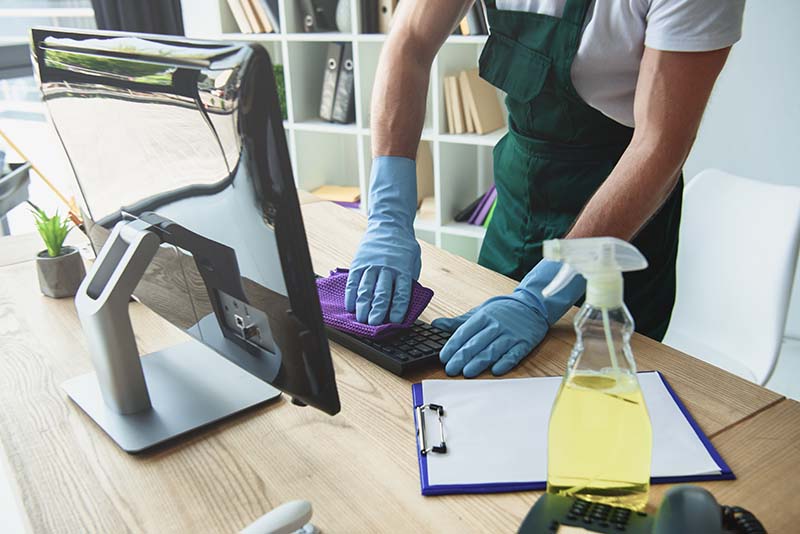
Beyond Dusting: Specialized Cleaning Services for Offices in Makati City
In bustling urban environments like Makati City, maintaining pristine office

Cleaning is not just about wiping away dirt and grime; it’s about ensuring surfaces are thoroughly cleansed. One crucial aspect of effective cleaning is absorption—the ability of a material to soak up liquid. In this blog post, we’ll delve into the science behind absorption and how it relates to the capacity of your cleaning cloth.
Absorption occurs when a substance permeates another substance. In the context of cleaning, absorption involves liquid being drawn into the fibers of a cleaning cloth. This process is facilitated by capillary action, where liquid moves through small spaces within the fabric. The greater the absorption capacity of a cleaning cloth, the more liquid it can hold, resulting in more efficient cleaning.
Several factors influence a cleaning cloth’s absorption capacity. The material composition plays a significant role—microfiber cloths, for example, are renowned for their superior absorption capabilities due to their densely packed fibers. Additionally, the weave or texture of the cloth affects its surface area and, consequently, its absorption capacity. Thicker and denser cloths generally have greater absorption capacities than thinner ones.
Microfiber cloths stand out for their exceptional absorption properties. The microscopic fibers create more surface area for liquid to be absorbed, making them highly effective for cleaning tasks. Cotton cloths, while not as absorbent as microfiber, are still a popular choice for cleaning due to their affordability and versatility. Other materials like bamboo and cellulose also offer varying degrees of absorption.
When selecting a cleaning cloth, it’s essential to understand the terminology used on labels. Terms like “highly absorbent” or “superior absorption” indicate that the cloth has been designed to soak up liquids efficiently. Pay attention to these labels to choose a cloth that meets your cleaning needs.
To maintain optimal absorption capacity, proper care and maintenance of cleaning cloths are crucial. Washing cloths in hot water with detergent helps remove dirt and oils that can inhibit absorption. Avoid using fabric softeners, as they can leave residues that reduce absorption. Additionally, using a technique like blotting rather than wiping can help maximize absorption during cleaning.
The absorption capacity of a cleaning cloth directly impacts its effectiveness in removing dirt, grease, and bacteria from surfaces. A cloth with high absorption can hold more liquid, allowing for more thorough cleaning with fewer passes. By understanding and optimizing absorption, you can achieve cleaner surfaces with less effort.
Choosing absorbent cleaning cloths can also have environmental benefits. By selecting high-quality cloths with long lifespans, you can reduce the need for disposable cleaning products, contributing to sustainability efforts. Additionally, some eco-friendly materials like bamboo offer both absorbency and biodegradability, further minimizing environmental impact.
Understanding the science of absorption is key to selecting the right cleaning cloth for your needs. By considering factors like material composition, weave, and thickness, you can choose a cloth with optimal absorption capacity. Maximize the effectiveness of your cleaning routine by caring for your cloths properly and using techniques that promote absorption. In doing so, you’ll achieve cleaner, healthier environments while minimizing waste and environmental impact.
Click n’ Clean stands tall as the expert provider of cleaning cloths and sponges. Choose excellence for your cleaning needs and witness the remarkable difference their products can make in your daily routine.

In bustling urban environments like Makati City, maintaining pristine office

In the bustling urban landscape of Makati City, maintaining hygiene

Keeping up with a rigorous home cleaning routine can often

In today’s fast-paced business world, maintaining a clean and organized

With the increasing emphasis on sustainability and environmental conservation, many

In today’s world, where environmental consciousness is becoming increasingly important,

In the bustling metropolis of Metro Manila, where urban living

Area rugs are more than just floor coverings; they’re design

In recent years, synthetic grass has emerged as a popular

Landscaping is more than just enhancing the aesthetics of outdoor
© 2024 All rights reserved. Best Cleaning Tool – Store